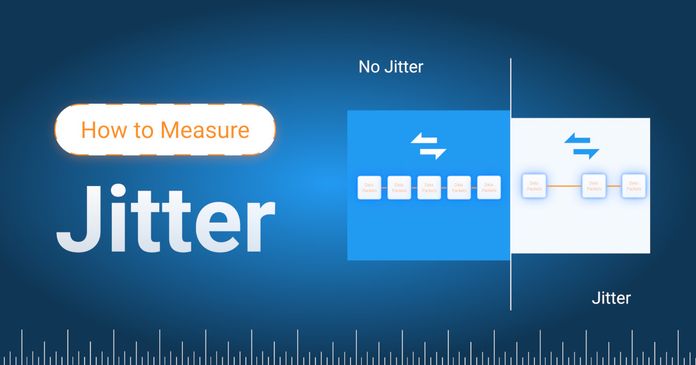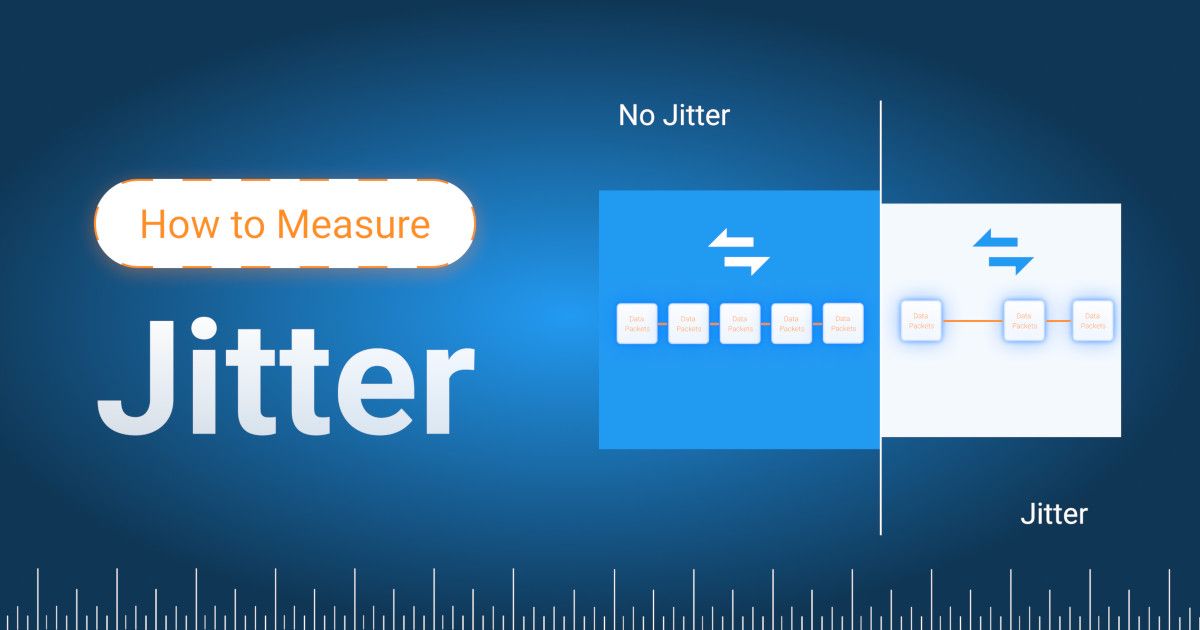Table of Contents
Table of Contents
Are you tired of constantly dropping calls or struggling to hear your loved ones on the other end of the line? Fear not, because we're here to talk about the one thing that can make or break your VoIP experience: MOS score. No, we're not talking about the fuzzy creature from Star Wars - we're talking about the Mean Opinion Score, the nifty little metric that can help you measure and improve the quality of your VoIP calls.
VoIP Quality is highly reliant on network performance, which means that many network problems like packet loss, latency, and jitter can cause high levels of VoIP degradation. To avoid embarrassing choppy voice calls, or lagginess during your next client meeting, we’re running you through how to measure VoIP Quality with MOS Score (Mean Opinion Score).
So grab a cup of coffee, settle in, and let's dive into the wonderful world of MOS scores and VoIP quality!
VoIP Quality refers to the overall level of audio and visual performance experienced during a Voice over Internet Protocol (VoIP) call. This includes factors such as call clarity, signal strength, delay, echo, and other audio and visual distortions that can impact the user experience.
VoIP Quality can be influenced by a variety of factors, including the quality of the internet connection, the type of device used for the call, and the network infrastructure supporting the call. Measuring and monitoring VoIP Quality is important to ensure that users are able to communicate effectively and efficiently, without experiencing frustrating audio or visual interruptions.


VoIP Quality is typically measured using a combination of objective and subjective metrics. Here are some common methods for measuring VoIP Quality:
- MOS score: The Mean Opinion Score (MOS) is a subjective metric that is obtained by having a group of people rate the quality of audio samples. MOS scores are widely used in the telecommunications industry to assess the quality of VoIP calls. We'll expand on MOS Score in the next section.
- R-factor: The R-factor is an objective metric that is used to measure the quality of VoIP calls. It takes into account factors such as delay, jitter, and packet loss to produce a score between 0 and 100. A higher R-factor indicates better call quality.
- Packet loss rate: Packet loss rate is the percentage of voice packets that are lost during transmission. A higher packet loss rate can result in poor call quality.
- Jitter: Jitter is the variation in delay between packets. High jitter can result in poor call quality.
- Latency: Latency is the delay that occurs between the time when a voice packet is sent and when it is received. High latency can result in poor call quality.
- Echo: Echo occurs when a caller hears their own voice back in their earpiece. Echo can be caused by network delays, poor echo cancellation, or other factors, and can result in poor call quality.
By measuring these metrics, VoIP Service Providers can identify areas where call quality needs improvement and take steps to improve the overall quality of their services.
The Mean Opinion Score, usually referred to as MOS Score, has been the most commonly-used metric to measure the overall voice call quality for decades. Standardized by the International Telecommunications Union (ITU-T), MOS Score refers to:
A numerical measure of the human-judged overall quality of voice and video sessions.

The MOS is obtained by having a group of people listen to a set of standardized audio samples and rate them on a scale of 1 to 5, with 1 being the lowest quality and 5 being the highest. The ratings are then averaged to obtain the MOS score.
The MOS score is widely used in the telecommunications industry to measure and monitor the quality of voice calls, including VoIP calls. By monitoring MOS scores, telecom companies can identify areas where call quality needs improvement and take steps to improve the overall quality of their services.
Voice Quality MOS Score is most often judged on a scale from 1 (bad) to 5 (excellent) of the perceived quality of a voice call. Although originally Mean Opinion Scores were derived from surveys of expert observers, today a MOS Score is often produced by an Objective Measurement Method approximating a human ranking.
The MOS Score (Mean Opinion Score) for Voice Quality was originally developed for traditional voice calls but has been adapted to Voice over IP (VoIP) in the ITU-T PESQ P.862.
The standard defines how to calculate MOS Score for VoIP Quality based on multiple factors such as the specific codec used for the VoIP call. Each VoIP codec (ex: G.711, G.722, G.723.1, G.729) behaves differently. Some codecs such as G.711 are uncompressed for higher quality but use more bandwidth than compressed codecs such as the G.729.
The MOS Score we measure is for the G.711 codec, which is by far the mostly used codec for VoIP calls. The maximum MOS Score for a G.711 call is 4.4.
During the MOS test, human participants are asked to listen to a series of pre-recorded speech samples or participate in live VoIP calls. After each sample or call, the participants are asked to rate the quality of the voice on a scale of 1 to 5, with 5 being excellent and 1 being unacceptable. The participants' ratings are then averaged to calculate the overall Mean Opinion Score for the VoIP call or service.
The MOS test considers several factors that can influence the voice quality, including:
- Clarity: How clear and distinct the voice sounds without any distortion or noise.
- Loudness: Whether the voice is at an appropriate volume level, not too loud or too quiet.
- Delay: The time it takes for the voice to be heard after speaking, also known as latency.
- Jitter: Variability in the delay between packets, which can cause choppy audio.
- Packet Loss: The percentage of voice packets that are lost during transmission, leading to gaps in audio.
- Background Noise: Any unwanted noise or interference during the call.
The MOS test results in a single score that provides a concise summary of the VoIP call quality. It gives VoIP service providers and network administrators valuable feedback on how users perceive the quality of their VoIP service. A higher MOS score indicates better voice quality and a more satisfactory user experience.
Typically, MOS scores are categorized as follows:
- 5: Excellent
- 4: Good
- 3: Fair
- 2: Poor
- 1: Unacceptable
VoIP MOS testing is essential for maintaining and improving VoIP services. It helps service providers identify and address issues that may negatively impact call quality, leading to a better overall user experience. By consistently conducting MOS tests and monitoring the scores, providers can make data-driven decisions to optimize their VoIP networks and ensure high-quality voice communication.

When deciding how we would be measuring VoIP Quality in the Obkio app, we decided to measure it based on the MOS Score. Here are the details for how we measure VoIP MOS Score. The table below lists the different qualities and the lowest MOS Score limit for each of them. The limit values are from the ITU-T standards.

We also realized that most of our customers were not very familiar with the MOS Score and the interpretation of MOS in VoIP Quality. To help all our users understand more easily, we redesigned the MOS Score graph to create the VoIP Quality graph.
Obkio’s MOS VoIP Quality graph categorizes, for every minute, the MOS Call Quality as
- Best
- High
- Medium
- Low
- or Poor
The exact MOS Voice Quality Score is always available in the graph tooltip.

This feature is a great measure of the Quality of Experience (QoE) for users using VoIP applications over their network and helps IT Pros evaluate the impact of Network Performance on VoIP Applications.
VoIP issues make up 50% of IT problems!
VoIP travels a long distance from your network, through the Internet, and up to your Service provider. That means that, when a problem occurs, no matter where it is, you need to manage it.
A VoIP monitoring tool is the best way to ensure accurate and continious VoIP Quality measurement - and Obkio Network Performance Monitoring software can help with that.
Obkio is a Network Monitoring and Troubleshooting tool with it's own VoIP Monitoring feature.

Network performance can have a significant impact on VoIP Quality. When making a VoIP call, the voice data is transmitted over the internet, and any issues with the network can cause delays, packet loss, and other disruptions that can affect call quality. Which is why it's important to monitor network and VoIP Quality all together.
Obkio's VoIP Monitor measurse VoIP Quality with MOS Score and start to proactive identify and troubleshoot VoIP issues before your users even know they exist!

To monitor VoIP Quality in all your network locations, for all your core VoIP apps, you need to deploy Network Monitoring Agents which continuously measure network performance in key network locations like offices, data centers and clouds.
The Agents exchange synthetic traffic between each other to measure core network metrics that are essential to VoIP Quality, like MOS score.
To collect the data you need to translate, you’ll need:
- Local Agents: Installed in the targeted office location experiencing VoIP Quality issues. There are several Agent types available (all with the same features), and they can be installed on MacOS, Windows, Linux and more.
- Public Monitoring Agent: These are deployed over the Internet and managed by Obkio. They compare network and VoIP performance up to the Internet and can be used to monitor VoIP Quality for apps like Microsoft Teams and Zoom. They can also help identify if the network and VoIP issue is global or specific to a destination.
As we explained earlier, a tool like Obkio will automatically measure your VoIP Quality for you! Once your Monitoring Agents are deployed, they will start exchanging synthetic traffic to measure VoIP Quality.
Obkio’s MOS VoIP Quality graph categorizes, for every minute, the MOS Call Quality as
- Best
- High
- Medium
- Low
- or Poor
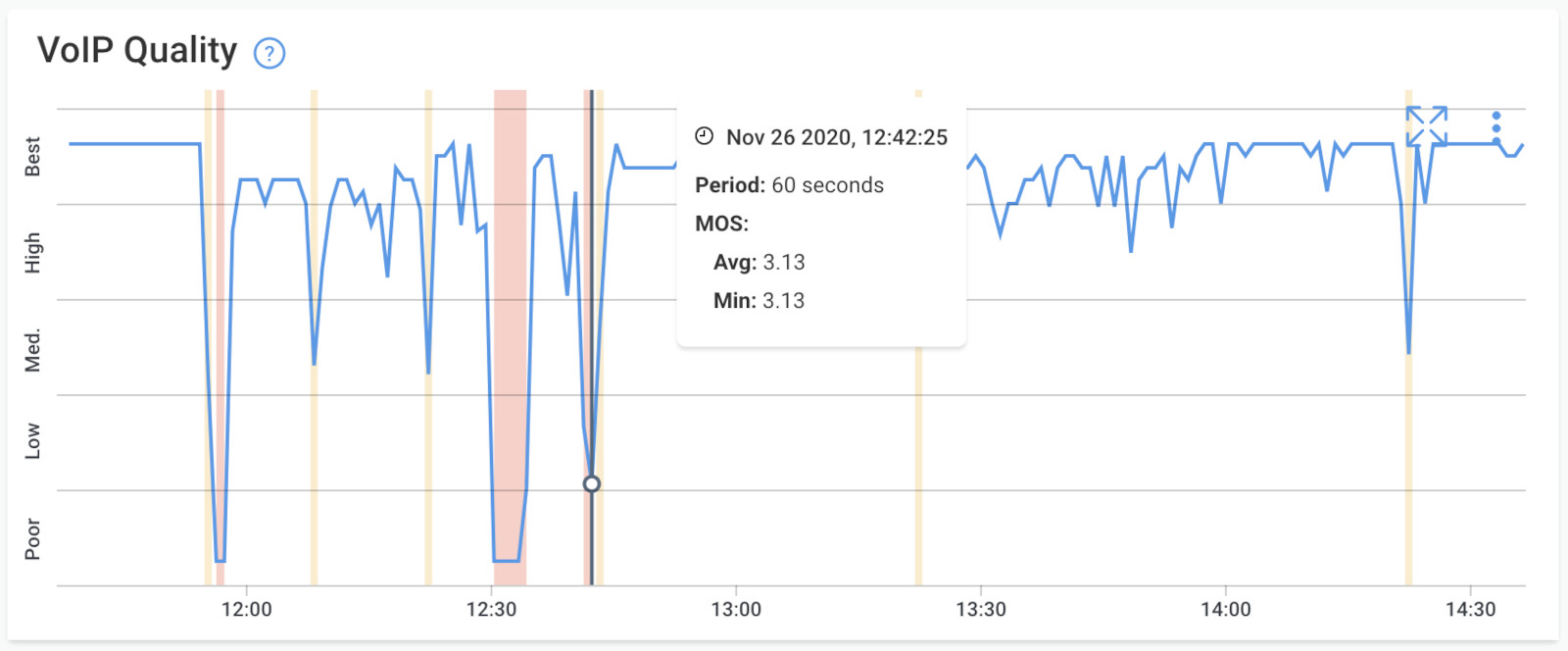
Once you’ve deployed Obkio Monitoring Agents in your key network locations, they will start measuring other key network metrics that essential to your network and VoIP performance.
Here are some metrics you can measure with Obkio that are detrimental to VoIP Quality:
Here are some ways that network performance can affect VoIP Quality:
- MOS score: As discussed earlier, the Mean Opinion Score (MOS) is a subjective metric that is used to assess the quality of human speech and other forms of audio. MOS scores can provide an overall measure of VoIP Quality and can help identify areas where call quality needs improvement.
- Bandwidth: VoIP calls require a certain amount of bandwidth to maintain call quality. If the network is congested or there is not enough bandwidth available, the call quality may suffer.
- Latency: Latency is the delay that occurs between the time when a voice packet is sent and when it is received. High latency can cause a delay in the conversation, making it difficult to communicate effectively.
- Jitter: Jitter is the variation in delay between packets. High jitter can cause the voice quality to degrade, resulting in a choppy or garbled conversation.
- Packet loss: Packet loss occurs when voice packets are dropped during transmission. Even a small amount of packet loss can result in poor call quality and affect the ability to understand the conversation.
To ensure high-quality VoIP calls, it is important to have a network that is capable of handling the required bandwidth and has low latency, jitter, and packet loss. Network monitoring and optimization can help identify and resolve any issues that may be affecting VoIP Quality.
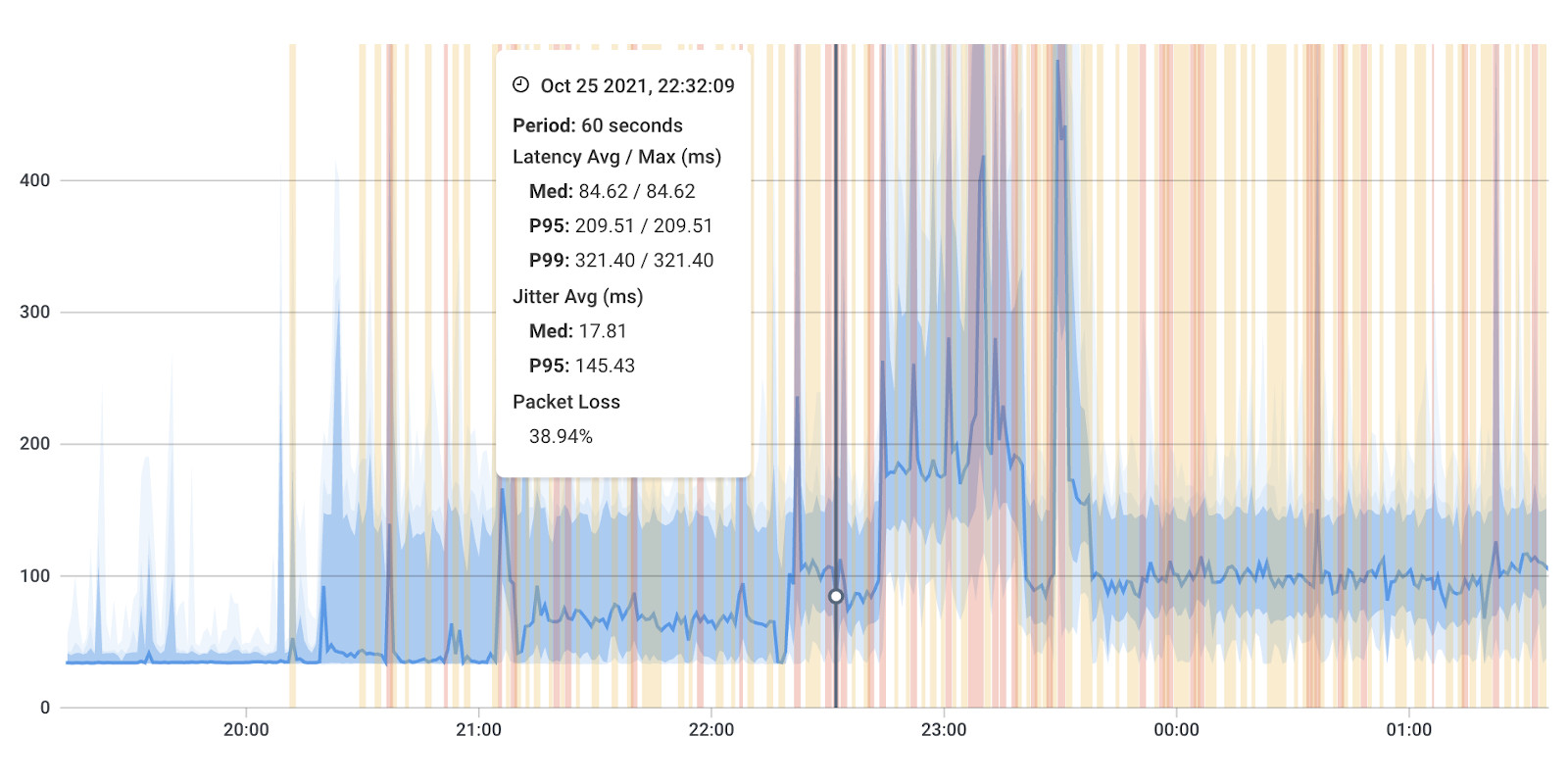
With this setup, you now have everything you need to identify and troubleshoot VoIP Quality issues. Obkio will automatically alert you of any VoIP performance degradation, MOS score changes, and VoIP Quality issues.
Here are some common VoIP Quality issues you may encounter There are several common VoIP quality issues that can affect the user experience. Here are some of the most common VoIP quality issues:
- Jitter: High jitter, especially VoIP jitter, can result in choppy or distorted audio, which can make it difficult to understand the conversation.
- Latency: High latency can cause delays in the conversation, making it difficult for users to have a natural conversation.
- Packet loss: High packet loss can result in gaps in the conversation, making it difficult to understand what is being said.
- Echo: Echo occurs when a user hears their own voice after speaking. This can be distracting and make it difficult to concentrate on the conversation.
- Noise: Noise can occur due to a variety of factors, such as network interference or equipment issues. This can make it difficult to understand what is being said and can be very distracting.
- Call drops: Call drops occur when a call is unexpectedly disconnected. This can be frustrating for users, especially if it happens frequently.
- Poor call setup time: Poor call setup time can make it difficult for users to make and receive calls quickly, leading to a poor user experience.
By identifying and addressing these common VoIP quality issues, VoIP service providers can improve the user experience and ensure that their systems deliver high-quality audio that meets the expectations of users.

When it comes to VoIP quality, there's a big difference between crystal-clear calls and garbled, robotic-sounding conversations. To help you distinguish between the two, we're breaking down what constitutes good VoIP quality versus bad.
Good VoIP quality is generally considered to be when voice calls are clear and have a natural sound that is similar to a traditional phone call. In general, good VoIP quality is characterized by the following:
- High MOS score: A MOS score of 4 or above is generally considered good VoIP quality.
- Low packet loss: A packet loss rate of less than 1% is generally considered good VoIP quality.
- Low jitter: Jitter of less than 30 milliseconds is generally considered good VoIP quality.
- Low latency: Latency of less than 150 milliseconds is generally considered good VoIP quality.
On the other hand, bad VoIP quality is characterized by poor audio quality that is often characterized by the following:
- Low MOS score: A MOS score of less than 3 is generally considered poor VoIP quality.
- High packet loss: A packet loss rate of more than 5% is generally considered poor VoIP quality.
- High jitter: Jitter of more than 50 milliseconds is generally considered poor VoIP quality.
- High latency: Latency of more than 300 milliseconds is generally considered poor VoIP quality.
Ultimately, what constitutes good or bad VoIP quality can depend on individual users' expectations and preferences. However, the general guidelines above can provide a useful benchmark for evaluating VoIP quality.
Unlock the secrets of VoIP monitoring! Discover tools, techniques, and the power of Obkio for unbeatable call quality. Begin your adventure today!
Learn more

Measuring VoIP (Voice over Internet Protocol) quality is crucial to ensure optimal performance and user satisfaction. There are several important VoIP metrics to consider when evaluating VoIP quality. These metrics can help identify and diagnose potential issues affecting call quality.
Some of the metrics we've already touched on in this article, but some may be new to you!
We've already discussed this very important metrics many time in this article, but it's worth presenting again!
MOS is a widely used metric to assess overall voice quality. It's typically rated on a scale of 1 to 5, with 5 being excellent and 1 being unacceptable. MOS is obtained by collecting subjective user feedback about call quality.
So we now know that a high MOS score means that you have great VoIP Quality! But what is considered a high MOS score rating?
MOS (Mean Opinion Score) measures the perceived quality of VoIP audio on a scale from 1 to 5, with 5 being the best possible score. A high MOS rate indicates that the audio quality is good, while a low MOS rate indicates poor audio quality.
In general, a MOS score of 4 or above is considered to be high-quality audio and indicative of a good VoIP experience. This means that users perceive the audio quality to be similar to that of a traditional phone call.
On the other hand, a MOS score of less than 3 is considered to be low-quality audio and indicative of a poor VoIP experience. This means that the audio quality is distorted, choppy, or robotic-sounding, making it difficult for users to understand the conversation.
Overall, aiming for a high MOS rate is important for delivering a good VoIP experience and ensuring that users are satisfied with the audio quality of their calls.
When it comes to measuring the performance of any technologies or application, the user-perspective is your most important metric. Users identify good performance because essentially, good performance is the ability to meet a user’s expectations.
Quality of Experience (QoE) is a metric that allows you to measure performance from the end-user perspective to gain a better understanding of human quality metrics and be able to actually measure whether performance met a user’s expectations.
QUALINET (The European Network on Quality of Experience in Multimedia Systems and Services), describes QoE as:
“The degree of delight or annoyance of the user of an application or service. It results from the fulfillment of his or her expectations with respect to the utility and / or enjoyment of the application or service in the light of the user’s personality and current state.”
QoE allows you to measure the user’s perception of the effectiveness and quality of a system or service to essentially give you a performance standard. In fact, users base their opinions about the network exclusively on their perception of QoE.
QoE and VoIP Quality are two metrics that really work hand-in-hand. You can actually use VoIP Quality as a way to measure QoE, because after all, if poor VoIP Quality is leading to choppy calls, and robot voices, you can be pretty certain that your user is not having a pleasant experience.

Nowadays, IP networks are used to transport various types of applications which are a lot more sensitive to network performance and quality. One of those applications is VoIP.
This is why network engineers implement QoS (Quality of Service) to prioritize some traffic on the network in order to reduce latency, jitter and packet loss. In case of a network congestion, this will ensure that performance sensitive applications are always running without degradation and that only the less critical applications (such as web browsing) are impacted.
Quality of Service (QoS) for VoIP is a set of techniques and mechanisms used to prioritize and manage network resources to ensure optimal and reliable performance for Voice over Internet Protocol (VoIP) traffic.
QoS (Quality of Service), is important for all VoIP Quality, because, at some point, voice and data will ‘mix’ on your network, or on the Internet. VoIP Call Quality can be measured using a variety of metrics, but it is more so perceived in regard to clarity of the voice quality heard at both ends of a call. The human ear is very sensitive, and will pick up on anything that may sound abnormal.
Quality of Service for VoIP allows us you set different priorities for different types of data Services on your network. To ensure that phone calls are good quality, we need to give VoIP traffic a higher priority than, for example, a download of a Windows 10 upgrade. That way, even with several computers doing upgrades on your network, calls are still crystal-clear.
VoIP Quality is about being able to get high-fidelity audio at each end of the phone call, without unwanted distortions. VoIP QoS will be affected by:
- Bandwidth
- Packet Loss
- Jitter
- Latency
Obkio allows you to continuously monitor QoS with DSCP features - specifically the DSCP code located in the IP header.
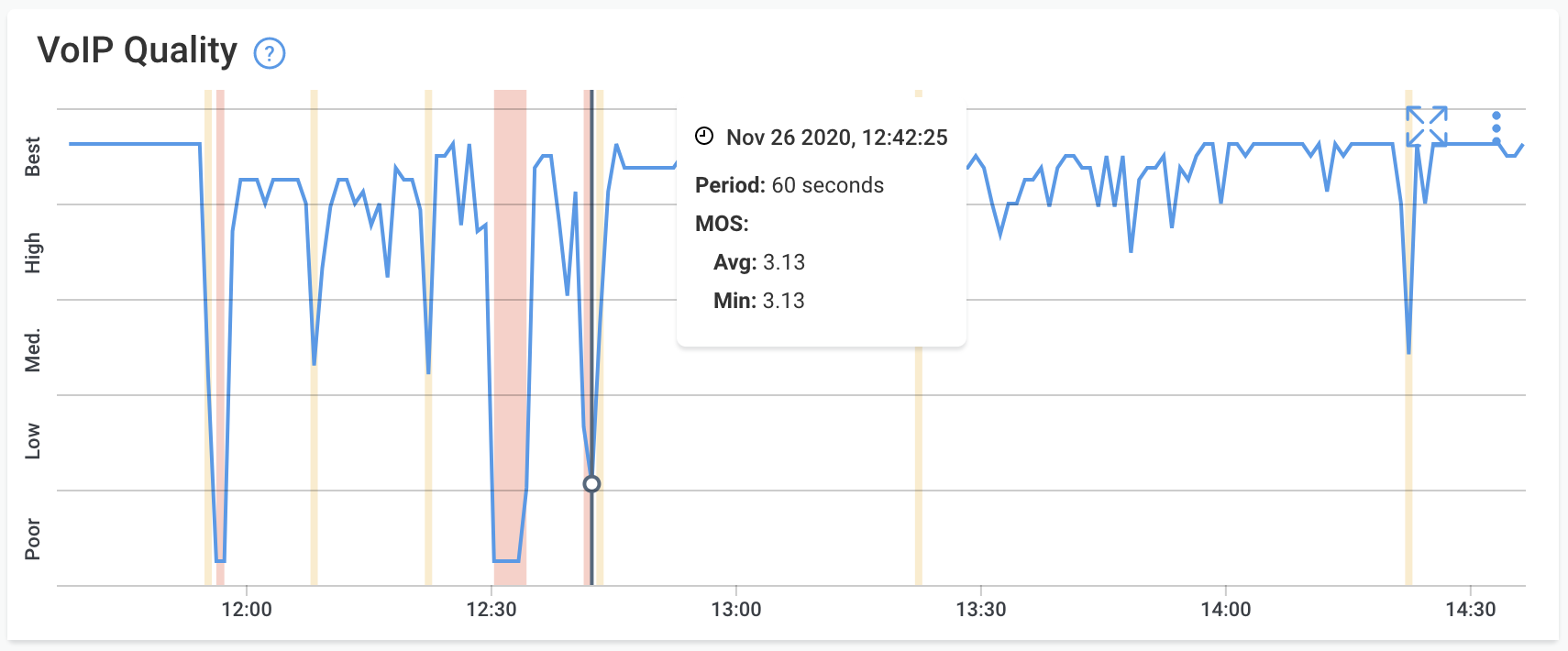
- Prioritization: QoS prioritizes VoIP packets over other types of non-real-time data traffic on the network. This ensures that voice packets receive preferential treatment and are delivered with minimal delays, even when the network is congested.
- Low Latency: Reducing latency is critical for VoIP to maintain real-time communication. QoS mechanisms prioritize VoIP packets to minimize the time it takes for voice data to traverse the network from the sender to the receiver.
- Jitter Management: QoS helps control jitter by using techniques like jitter buffers, which temporarily store incoming packets and release them at a steady rate. This helps mitigate the effects of packet arrival variations and ensures smoother playback of voice data.
- Packet Loss Mitigation: QoS mechanisms reduce the likelihood of packet loss by giving priority to VoIP packets and ensuring that they are less likely to be dropped, even in situations of network congestion.
Optimize VoIP performance with QoS implementation. Explore best practices for QoS for VoIP, overcome challenges, and elevate clarity with Obkio's NPM tool.
Learn more

Jitter is a phenomenon that occurs in data networks, including the Internet, where data packets experience varying delays in their arrival times at the destination. In the context of VoIP, jitter refers to the inconsistency in the arrival of voice packets, which can negatively impact call quality.
In a VoIP call, voice data is divided into small packets before being transmitted over the network. These packets need to arrive at the destination in a steady and consistent manner to reconstruct the voice signal properly. However, due to network congestion, routing inefficiencies, or other factors, the packets may experience different travel times, causing jitter.
Here's how excessive jitter can affect VoIP call quality:
- Choppy Audio: When packets arrive with significant variations in delay, the receiving end may experience interruptions in audio playback, leading to choppy or broken voice. It can make the conversation difficult to understand, resulting in a frustrating user experience.
- Out-of-Order Packets: In severe cases of jitter, packets might arrive at the destination out of order. The VoIP application needs to reorder them correctly, which can cause additional delays and further degrade voice quality.
- Packet Loss: If jitter is extreme, it can lead to packets arriving too late or being dropped altogether. Packet loss in VoIP can result in missing parts of the conversation, leading to gaps in audio or complete drops in speech.
- Echo: Jitter can also cause echo, where parts of the sender's voice are played back to them as an echo. This can happen when packets containing the sender's voice arrive out of order and are played back later than expected.
Acceptable jitter for VoIP is typically kept within a narrow range to ensure good call quality. The goal is to keep jitter at a level that minimizes its impact on the VoIP call without introducing noticeable degradation in voice quality. While there is no universally defined threshold, a general guideline is to aim for jitter to be below 30 milliseconds (ms) for optimal VoIP performance.
Here's a breakdown of jitter levels and their impact on VoIP quality:
- Low Jitter (Below 10 ms): This is considered excellent and should result in very minimal or no noticeable impact on call quality. VoIP calls should be clear and reliable at this level of jitter.
- Moderate Jitter (10 ms to 20 ms): While still generally acceptable, jitter in this range may cause occasional minor disruptions in call quality, but users are unlikely to experience significant issues.
- High Jitter (20 ms to 30 ms): At this level, users may start to notice occasional choppiness or brief interruptions in the audio during calls. While still somewhat acceptable, efforts should be made to reduce jitter to improve call quality.
- Excessive Jitter (Above 30 ms): Jitter beyond 30 ms can significantly degrade VoIP call quality. Users are likely to experience frequent audio disruptions, choppy voice, and potential gaps in communication.
The maximum jitter for VoIP should generally be kept as low as possible to ensure optimal call quality. While there is no fixed universally accepted maximum jitter threshold, the commonly recommended maximum jitter for VoIP is around 30 milliseconds (ms) or less.
Measuring jitter with a Network Monitoring tool, like Obkio, will help you understand if your jitter levels are increasing above the desired thresholds, and negatively impacting the most sensitive applications, like VoIP.
Learn how to measure network jitter using Obkio’s Network Monitoring software to identify network problems & collect data to troubleshoot.
Learn more

Latency is a critical metric in data networking and has a significant impact on the performance of real-time applications like VoIP. It refers to the time it takes for a data packet to travel from the sender to the receiver across a network. In the context of VoIP, latency directly affects the delay experienced by users during a conversation.
There are generally three types of latency in VoIP:
- Transmission Latency: This is the time it takes to encode the voice data into packets and transmit them over the network to the destination. This includes the time it takes for the data to leave the sender's device and reach the network router or gateway.
- Propagation Latency: Propagation latency is the time it takes for the data packets to travel across the physical distance between the sender and the receiver. This type of latency is influenced by the physical medium used for transmission, such as copper wires, fiber-optic cables, or wireless links.
- Processing Latency: Processing latency occurs at network devices like routers and switches, where the packets may experience some delay due to queuing, buffering, and decision-making processes.
High latency in VoIP can lead to the following issues:
- Delays in Conversations: High latency causes noticeable delays between when a person speaks and when the other party hears the response. This delay can be frustrating and disruptive during real-time communication.
- Talk-Over Effects: In some cases, when latency is extremely high, the conversation may become difficult to manage, as people might unintentionally speak over each other due to the delayed audio.
- Negative User Experience: Latency negatively impacts the user experience, leading to reduced efficiency and potentially affecting the clarity of communication.
- Impact on VoIP Call Quality: Latency can lead to audio disruptions, choppiness, and gaps in voice communication, resulting in poor call quality.
[VoIP latency(/blog/voip-latency/) requirements can vary based on the specific use case and user expectations. Generally, the goal is to keep latency at levels that provide a seamless and natural conversation experience, similar to traditional landline telephone calls. The acceptable VoIP latency requirements depend on the type of VoIP application and the user's tolerance for delays. Here are some common latency requirements for different VoIP scenarios:
- Consumer VoIP: For residential or consumer VoIP services, the acceptable latency typically ranges from 100 to 150 milliseconds (ms). Most users can comfortably conduct conversations with this level of latency without noticing significant delays.
- Business VoIP: In business environments, where call quality is crucial for professional communication, the target latency is usually lower, around 50 to 100 ms. Lower latency ensures that business calls are crisp and responsive.
- Contact Centers: In call centers and customer support environments, where efficient communication is essential, the target latency is often below 50 ms. This is to enable real-time interactions between agents and customers without noticeable delays.
- Video Conferencing: For VoIP-based video conferencing applications, including web conferencing and virtual meetings, the acceptable latency is around 150 to 250 ms. Lower latency is preferred, but some tolerance is given due to the additional data processing involved in video transmission.
It's important to note that while lower latency is generally desired, achieving extremely low latency can be challenging, especially in networks with multiple hops and varying levels of congestion. Additionally, latency is influenced by factors like network distance, routing efficiency, and the type of network connection (wired vs. wireless).
To meet VoIP latency requirements, network administrators and service providers can take the following measures:
- Quality of Service (QoS): Implement QoS mechanisms to prioritize VoIP traffic and ensure that it receives preferential treatment over other types of data traffic on the network.
- Network Optimization: Optimize the network infrastructure to minimize the number of hops and reduce packet processing times.
- Jitter Buffering: Use jitter buffers at VoIP endpoints to manage and smooth out variations in packet arrival times, helping to reduce latency and jitter-related issues.
- Bandwidth Management: Ensure sufficient bandwidth for VoIP traffic to prevent congestion and excessive delays.
By continuously measuring latency and maintaining acceptable VoIP latency levels, service providers and businesses can provide high-quality communication services, that will undoubtably increase user satisfaction and improve productivity during your business' VoIP calls!
The maximum acceptable latency for VoIP depends on the specific use case and user expectations. Generally, for most VoIP applications, the maximum latency should be kept below 150 milliseconds (ms) to provide a satisfactory user experience. However, the ideal target for maximum latency is typically lower, around 100 ms or less.
Here are some guidelines about how different latency levels impact VoIP quality:
- Low Latency (Below 50 ms): Excellent for VoIP, with minimal perceptible delay. Calls feel immediate and responsive.
- Acceptable Latency (50 ms to 100 ms): Generally considered acceptable for most business and consumer VoIP applications. Users may notice a slight delay, but it is not usually disruptive to conversations.
- Marginal Latency (100 ms to 150 ms): At this level, users may experience noticeable delays in conversations. While still tolerable, call quality may be slightly impacted.
- High Latency (Above 150 ms): Latency beyond 150 ms can significantly affect the quality of VoIP calls. Users may experience delayed and disjointed conversations, leading to reduced call clarity and communication difficulties.
Learn how to measure latency with Obkio’s Network & Latency Monitoring tool. Check for latency in your network & analyze latency measurements.
Learn more

Packet loss is a common phenomenon in data networks, including the internet, where data packets may fail to reach their intended destination. In the context of VoIP, packet loss is a critical metric as it directly affects the quality of voice communication during calls.
When a VoIP call is made, the voice data is divided into small packets and transmitted over the network to the receiver. Ideally, all these packets should reach their destination intact and in the correct order. However, due to various network issues, some packets may be lost along the way.
Here's how packet loss impacts VoIP call quality:
- Audio Gaps: When packets are lost, parts of the voice conversation go missing, leading to gaps or silence in the audio. This can make the call sound choppy or disjointed, making it difficult for users to understand each other.
- Reduced Voice Clarity: Packet loss can result in distorted or garbled voice quality. As voice packets are dropped, the audio may become unclear or even unintelligible, making it challenging to carry on a conversation.
- Conversation Disruption: Repeated or prolonged packet loss can cause significant disruptions in the conversation flow. Users may have to repeat themselves, leading to frustration and a less efficient communication experience.
- Echo and Jitter: Packet loss can also contribute to echo and jitter issues. Echo occurs when the sender's voice is played back as an echo to them, while jitter is caused by variations in packet arrival times. Packet loss can exacerbate these problems and make them more noticeable during calls.
Even a small amount of packet loss can have a noticeable impact on VoIP call quality, especially during real-time communication where immediate feedback is essential. That's why measuring packet loss with a network monitoring tool like Obkio is important to monitoring and solving packet loss in your network, before it affects sensitive applications like VoIP and UC.
In VoIP, any amount of packet loss can have a negative impact on call quality, as it can lead to audio disruptions and gaps in communication. However, it is challenging to achieve a network with absolutely zero packet loss due to the nature of data transmission over the internet. Therefore, acceptable packet loss for VoIP is typically set at or near 0%.
VoIP is a real-time communication application, and even a small percentage of packet loss can result in noticeable call quality degradation, such as choppy audio and reduced voice clarity. In an ideal scenario, VoIP systems should strive for zero packet loss to ensure optimal call quality.
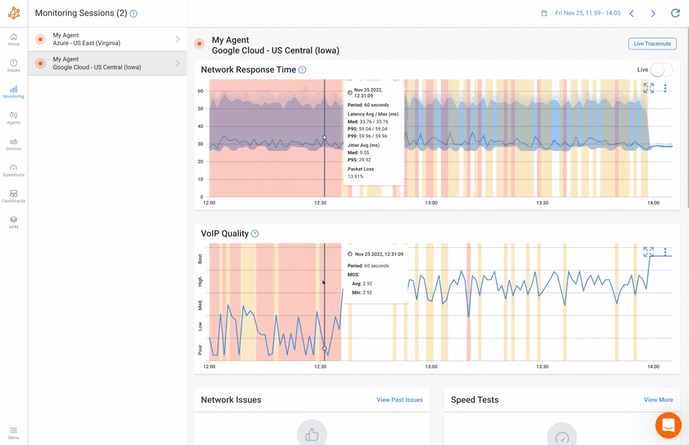

QoS (Quality of Service) for MOS (Mean Opinion Score) refers to the ability of a VoIP system to deliver high-quality audio that meets the expectations of users. QoS for MOS is typically achieved through a combination of network design, equipment selection, and network management practices.
To achieve QoS for MOS, VoIP service providers may implement various strategies, such as:
- Prioritizing voice traffic over other types of network traffic to ensure that voice packets are given priority over data packets.
- Implementing Quality of Service (QoS) mechanisms such as traffic shaping, traffic policing, and traffic prioritization to manage network traffic and ensure that voice packets are delivered with minimal delay, packet loss, and jitter.
- Selecting high-quality VoIP equipment such as routers, switches, and IP phones that are designed to handle the demands of VoIP traffic.
- Monitoring network performance using tools such as network monitoring tools like Obkio, network analyzers, packet sniffers, and other monitoring tools to identify issues that could affect call quality and take corrective actions.
By implementing QoS strategies, VoIP service providers can ensure that their systems deliver high-quality audio that meets the expectations of users, as reflected in MOS scores. This can lead to improved user satisfaction, better business outcomes, and increased customer loyalty.
When looking at how to calculate MOS Score, network metrics give you the most value and detail when they’re combined to give you a full overview.
Network Device Monitoring is a feature that allows you to monitor the performance of networking devices such as firewalls, routers, switches and wifi access points is crucial for IT teams.
The Device Monitoring feature inside the Obkio Software is a fast and easy solution to get detailed information about the health of devices using Ultra-Fast Polling (every 30 seconds).


Along with Device Monitoring, using a complete end-to-end Network Monitoring tool, monitoring VoIP MOS Score with Obkio’s Network Monitoring solution and Network Device Monitoring allows you to truly understand VoIP Quality from the end-user perspective.
Obkio measures performance from the end-user perspective by monitoring synthetic traffic every 500ms! This synthetic testing techniques allows for more proactive network issue detection - with no packet capture required.
This allows you to perform a network assessment of your entire network infrastructure to identify exactly:
- What network problems?: It’s important to find out what network problems are affecting VoIP Quality to be able to begin network troubleshooting. As I mentioned earlier, there are a variety of network problems that can affect VoIP performance, such as packet loss, jitter, and bandwidth.
- Where problems are located: Modern networks are vast infrastructures that can span over a variety of locations. When a problem arises, it is important to pinpoint where VoIP issues are located along your network so you know where to focus your troubleshooting efforts.
- Who the owner of the problem is: Your business may only have one IT specialist, or you may have a large IT department with different employees responsible for different parts of the network. Identifying who is responsible for dealing with a problem affecting VoIP Quality (user, application, network, or ISP), will help you decide who is responsible for fixing it.
- How to solve problems: Once you’ve collected all the information from the three previous points, you can assess the data to come to a resolution. It’s a given that having as much information as possible will lead to a quick and efficient solution.
You can check out the Network Performance Monitoring case study with Station 22, an international beverage manufacturer and distributor, to find out how they pinpointed undetected network problems on their firewall using MOS Score, Network Performance Monitoring, and Network Device Monitoring.
He’s a little summary about their problem and their solution.
Station 22 began experiencing VPN network application slowness and instability for their Microsoft Teams and GoToMeeting application.
Using Obkio’s Network Performance Monitoring software, they identified that their network latency was constant but the packet loss kept increasing. Specifically, there was a lot of packet loss occurring over the Internet as the bandwidth usage increased during the day, likely due to increased activity from users. They pinpointed the exact percentage of packet loss in the Obkio app with the graph tooltip.
They looked into the MOS Score chart to find that it reported thresholds well above what is normally acceptable.
Finally, they moved to Obkio's Network Device Monitoring feature on their firewall and saw that the CPU usage was well above the 40% threshold shown on their Firewall's GUI.

By using all three features, Station 22 was able to get a complete overview of all of the metrics affecting their network performance, and realized that the type of problem they were facing was known and could be fixed with a firmware update of the firewall. They immediately performed emergency maintenance and the problem was resolved in no time.
Congratulations, you're now a VoIP quality measuring expert! By understanding the metrics and factors that contribute to VoIP quality, such as MOS score, packet loss, jitter, and latency, you're well-equipped to diagnose and troubleshoot any issues that arise with your VoIP system.
Network performance, specifically VoIP Quality, can be affected by a variety of different factors, which is why it’s important to get a complete, end-to-end overview of all these factors to truly understand what is wrong, and how to fix it.
Whether you're a business looking to improve your customer service or an individual seeking a high-quality VoIP experience, these tools and tips will help you ensure that your calls are crystal-clear and enjoyable. So go forth, make some VoIP calls, and experience the magic of high-quality audio!
Put It to the Test: Trying Is the Ultimate Way to Learn!
Start monitoring VoIP Quality and MOS Score in minutes using Obkio's end-to-end network monitoring tool!
- 14-day free trial of all premium features
- Deploy in just 10 minutes
- Monitor performance in all key network locations
- Measure real-time network metrics
- Identify and troubleshoot live network problems

You can rest assured that we're not like those pushy Sellsy people - there's no catch here. We firmly believe in the excellence of our product, but if it's not the right fit for you, we understand and want what's best for you.
 Obkio Blog
Obkio Blog






